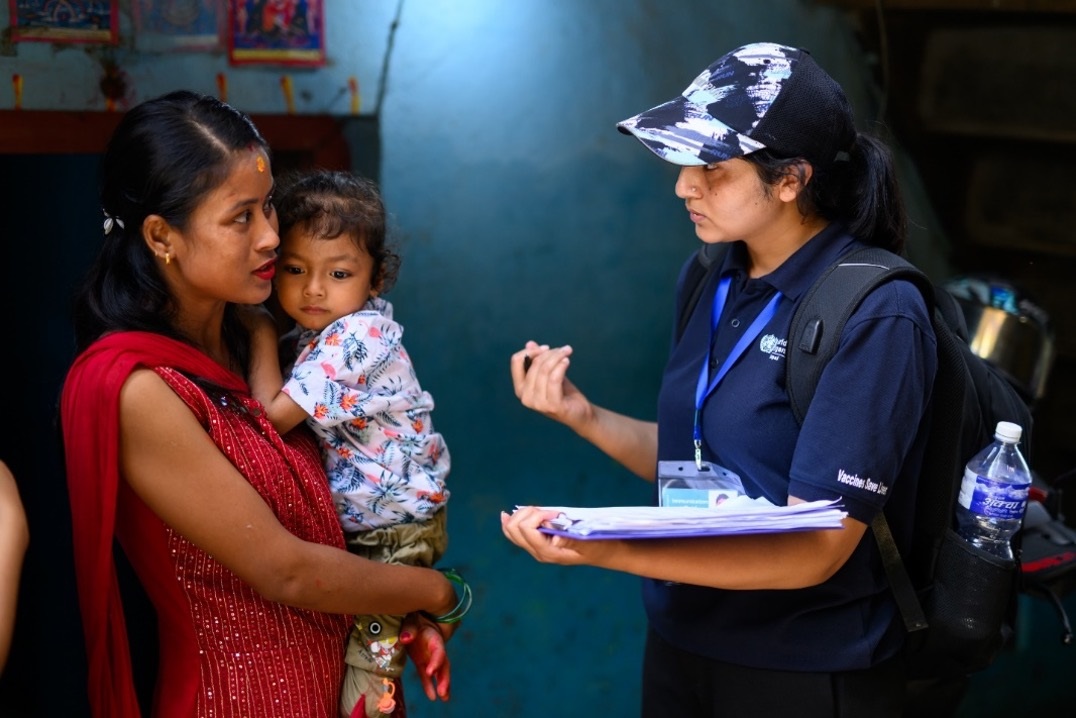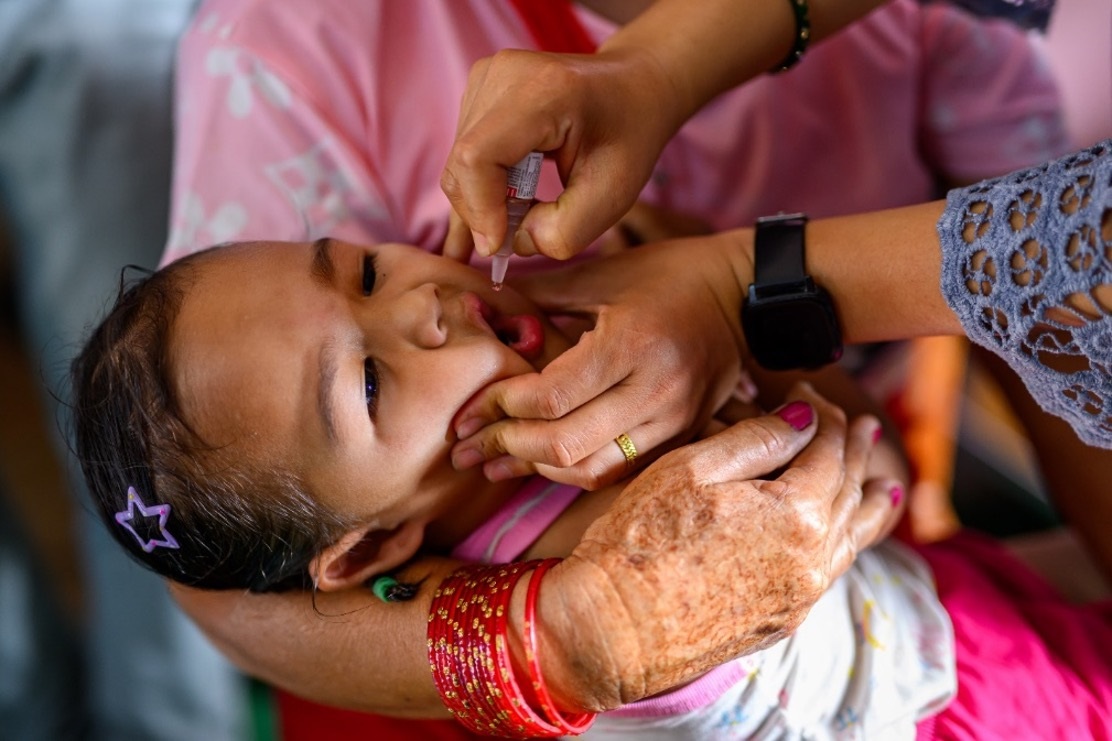/data-and-analytics-(dna)/data-exchange-(dex)/who-presence-in-countries--territories-and-areas.tmb-1920v.jpg?sfvrsn=f1146a2_2)
Rapid response to vaccine-derived poliovirus type 3 event in Nepal
Stronger WHO country presence for a healthier and safer world
Joint Outcome 6.1.
Detection of and response to acute public health threats is rapid and effective
On 13 July 2024, Nepal detected vaccine-derived poliovirus type 3 (VDPV3) in a sewage sample collected from an environmental surveillance site in Kathmandu, with confirmation from the World Health Organization (WHO) Regional Reference Laboratory for South-East Asia, based at the National Institute of Health in Bangkok. The virus, characterized by 11 nucleotide changes, raised immediate concerns due to its potential for transmission. As a polio-free country since 2010, Nepal acted swiftly to mitigate the risk of outbreak and prevent further spread. WHO, in coordination with Nepal’s Ministry of Health and Population (MoHP), the National Immunization Programme (NIP) and other key stakeholders, provided technical assistance for risk assessment, surveillance enhancement and rapid immunization interventions. As a result, Nepal successfully strengthened its polio surveillance, identified immunization gaps and rapidly vaccinated over 300 000 children, reinforcing its polio preparedness and response capacity.
WHO’s interventions and tailored support
On 13 July 2024, Nepal detected vaccine-derived poliovirus type 3 (VDPV3) in a sewage sample collected from an environmental surveillance site in Kathmandu, with confirmation from the World Health Organization (WHO) Regional Reference Laboratory for South-East Asia, based at the National Institute of Health in Bangkok. The virus, characterized by 11 nucleotide changes, raised immediate concerns due to its potential for transmission. As a polio-free country since 2010, Nepal acted swiftly to mitigate the risk of outbreak and prevent further spread. 1.WHO, in coordination with Nepal’s Ministry of Health and Population (MoHP), the National Immunization Programme (NIP) and other key stakeholders, provided technical assistance for risk assessment, surveillance enhancement and rapid immunization interventions. As a result, Nepal successfully strengthened its polio surveillance, identified immunization gaps and rapidly vaccinated over 300 000 children, reinforcing its polio preparedness and response capacity.

A WHO independent field volunteer conducts immunization profile monitoring at a high-risk area in Kathmandu, July 2024.
WHO’s interventions and tailored support
Following the detection of VDPV3, Nepal’s health authorities took immediate action, with WHO playing a critical role in guiding and supporting the national response. Within 24 hours of notification, the central leadership at the NIP conducted a desk review and initial risk assessment, with technical support from WHO Nepal and the WHO Regional Office for South-East Asia. The International Health Regulations focal point promptly notified WHO’s Regional Office, enabling a coordinated response.
Within 72 hours, high-level multi-stakeholder meetings were convened, chaired by the Secretary of the MoHP and the Director-General of the Department of Health Services. These meetings engaged key immunization committees, including the National Immunization Advisory Committee (NIAC), the National Certification Committee for Polio Eradication and the National Adverse Event Following Immunization Investigation Committee, as well as WHO and other partners, ensuring a prompt, coordinated and evidence-based response.
WHO support included
Enhanced surveillance and rapid field response
WHO Nepal facilitated a joint field visit to the environmental surveillance site and its catchment area. Within four days, three additional temporary environmental surveillance sites were identified, and sample collection frequency was increased. WHO surveillance and immunization medical officers (SIMOs) were deployed to Kathmandu, intensifying acute flaccid paralysis (AFP) surveillance across 168 health facilities. This resulted in the identification of 26 new potential informers and seven new AFP cases, and the collection of stool samples from seven healthy children for testing.

A health worker administers bivalent oral polio vaccine during the preventive rapid response vaccination campaign in Kathmandu, July 2024.
Deployment of immunization field monitors
To further support the outbreak response, WHO rapidly recruited and trained over 50 immunization field monitors (IFMs). High-risk areas were mapped, and the IFM and SIMO teams conducted a GPS-enabled rapid routine household immunization assessment, revealing 18 unimmunized (0.5%) and 187 under-immunized children (5.5%) out of 3375 monitored.
Preventive rapid response vaccination campaign
Based on the risk assessment and recommendations from the NIAC, the NIP launched a targeted preventive rapid response vaccination campaign, vaccinating over 300 000 children under 5 in three high-risk districts.
The campaign achieved a remarkable 168% official coverage rate. WHO also supported rapid convenience monitoring in 380 high-risk communities, identifying 527 missed children, all of whom were subsequently vaccinated.
Community engagement and risk communication
To address community concerns, WHO supported the activation of a toll-free hotline (1115), which handled 2647 queries. WHO also supported the development and dissemination of communication materials, including infographics, frequently asked questions and public service announcements (via radio, television and social media) to strengthen community awareness and engagement. The response was closely supported and monitored by the NIP’s central leadership, with support from WHO and other international agencies.
Nepal’s rapid response highlighted its ability to effectively manage public health threats and emergencies through robust coordination, high-level commitment and timely action. The event underscored the importance of maintaining high routine immunization coverage, even in polio-free countries. Key lessons learned include:
- The need for sustained and adaptive immunization strategies to close coverage gaps, even in well-performing areas;
- The effectiveness of WHO’s rapid response model in mobilizing technical support, field personnel and risk communication strategies in record time;
- The importance of continuous investment in polio preparedness, including updated and practical preparedness plans and adequate resource allocation, to enable immediate and effective action against the persistent threat of vaccine-derived polioviruses until global eradication is achieved.
WHO will continue to support Nepal in strengthening its polio surveillance and response mechanisms, ensuring the sustainability of environmental surveillance and immunization efforts. The success of this rapid response serves as a model for future preparedness and demonstrates Nepal’s commitment to safeguarding public health. By addressing immunization gaps, enhancing surveillance and maintaining readiness, Nepal plays a critical role in the global fight against polio, reinforcing regional health security and contributing to the ongoing efforts towards global eradication.
